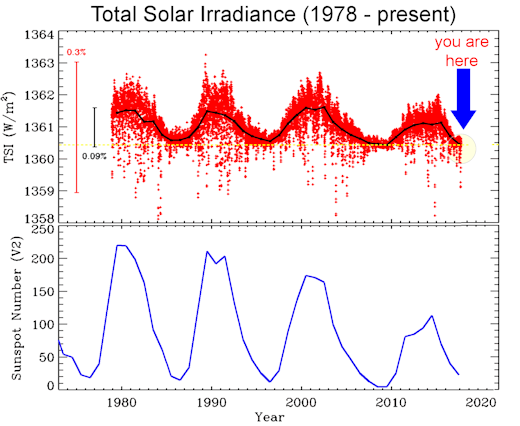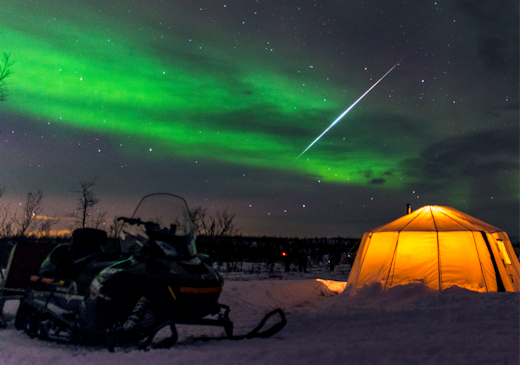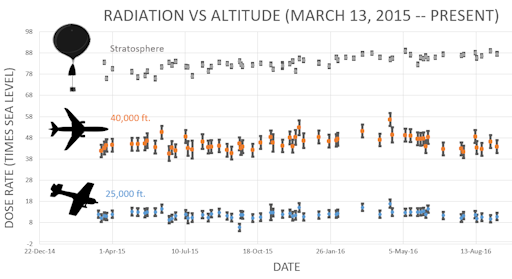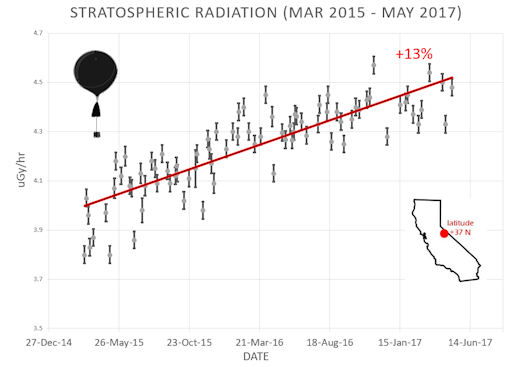Lights Over Lapland is excited to announce that we now have TWO aurora webcams covering nearly a 200° view of Abisko National Park in Sweden! Watch the auroras dance live, all season long here. | | |
THE NEXT SOLAR WIND STREAM: A hole in the sun's atmosphere is facing Earth, and it is spewing a stream of solar wind toward our planet. Estimated time of arrival: Dec. 17th. Arctic sky watchers should be alert for auroras when the gaseous material arrivals. Free: Aurora Alerts.
THE SUN IS DIMMING: Today at Cape Canaveral, SpaceX launched a new sensor to the International Space Station named TSIS-1. Its mission: to measure the dimming of the sun. As the sunspot cycle plunges toward its 11-year minimum, NASA satellites are tracking a decline in total solar irradiance (TSI). Across the entire electromagnetic spectrum, the sun's output has dropped nearly 0.1% compared to the Solar Maximum of 2012-2014. This plot shows the TSI since 1978 as observed from nine previous satellites:

Click here for a complete explanation of this plot.
The rise and fall of the sun's luminosity is a natural part of the solar cycle. A change of 0.1% may not sound like much, but the sun deposits a lot of energy on the Earth, approximately 1,361 watts per square meter. Summed over the globe, a 0.1% variation in this quantity exceeds all of our planet's other energy sources (such as natural radioactivity in Earth's core) combined. A 2013 report issued by the National Research Council (NRC), "The Effects of Solar Variability on Earth's Climate," spells out some of the ways the cyclic change in TSI can affect the chemistry of Earth's upper atmosphere and possibly alter regional weather patterns, especially in the Pacific.
NASA's current flagship satellite for measuring TSI, the Solar Radiation and Climate Experiment (SORCE), is now more than six years beyond its prime-mission lifetime. TSIS-1 will take over for SORCE, extending the record of TSI measurements with unprecedented precision. It's five-year mission will overlap a deep Solar Minimum expected in 2019-2020. TSIS-1 will therefore be able to observe the continued decline in the sun's luminosity followed by a rebound as the next solar cycle picks up steam. Installing and checking out TSIS-1 will take some time; the first science data are expected in Feb. 2018. Stay tuned.
Realtime Space Weather Photo Gallery
ARCTIC GEMINID FIREBALLS: Geminid meteor activity is rapidly subsiding on Dec. 15th--but not without a closing flourish. As Friday dawned in Abisko, Sweden, Lights over Lapland guest David Williams witnessed "a great display of both Northern Lights and some spectacular Geminids." He photographed several bright fireballs streaking over his snowy campsite:

Meteor expert Peter Jenniskens of NASA Ames says late Geminid fireballs are not unusual. "Geminids seen during the night of Dec. 14/15 tend to be brighter, on average, than those during the peak night of Dec. 13/14, because the debris stream of rock comet 3200 Phaethon is mass segregated." Smaller meteoroids arrive first, followed by bigger particles as the shower begins to subside.
The Geminid meteor shower will probably be finished, fireballs and all, by Dec. 16/17. Until then, keep an eye on the constellation Gemini during the dark hours before dawn. Something bright might surprise you. [sky map]
Realtime Space Weather Photo Gallery
URSINE ASTRONAUTS: Looking for a gift for the young scientist in your life? Consider the space bear. On Dec. 9, 2017, the students of Earth to Sky Calculus launched an array of cosmic ray sensors to the stratosphere onboard a giant helium balloon. These bears went along for the ride. As they ascended, the sun set, and the rays of the setting sun colored the mountainous landscape vivid pink:

The payload flew 33.5 km (109,908 feet) above the Sierra Nevada mountains of central California. According to the radiation sensors, cosmic ray levels were 100 times Earth-normal as the Ursine Astronauts reached the top of our planet's atmosphere and touched the edge of space.
You can have one for $49.95. Each bear comes with a Christmas card showing the cuddly creature in space. The inside flap tells the story of the flight and confirms that the bear has traveled to the edge of space and back again.
Far Out Gifts: Earth to Sky Store
All proceeds support hands-on STEM education
Realtime Aurora Photo Gallery
Every night, a network of
NASA all-sky cameras scans the skies above the United States for meteoritic fireballs. Automated software maintained by NASA's Meteoroid Environment Office calculates their orbits, velocity, penetration depth in Earth's atmosphere and many other characteristics. Daily results are presented here on Spaceweather.com.
On Dec. 15, 2017, the network reported 331 fireballs.
(194 Geminids, 128 sporadics, 4 December Leonis Minorids, 3 December Monocerotids, 1 sigma Hydrid, 1 Comae Berenicid)

In this diagram of the inner solar system, all of the fireball orbits intersect at a single point--Earth. The orbits are color-coded by velocity, from slow (red) to fast (blue). [Larger image] [movies]
Potentially Hazardous Asteroids (
PHAs) are space rocks larger than approximately 100m that can come closer to Earth than 0.05 AU. None of the known PHAs is on a collision course with our planet, although astronomers are finding
new ones all the time.
On December 15, 2017 there were 1872 potentially hazardous asteroids.
 |
Recent & Upcoming Earth-asteroid encounters: | Asteroid | Date(UT) | Miss Distance | Velocity (km/s) | Diameter (m) |
| 2017 WV12 | 2017-Dec-09 | 3.4 LD | 10.6 | 27 |
| 2017 XZ2 | 2017-Dec-10 | 3.9 LD | 8.2 | 12 |
| 2017 XE2 | 2017-Dec-10 | 11.1 LD | 9.9 | 31 |
| 2017 WE13 | 2017-Dec-12 | 16.4 LD | 5.3 | 26 |
| 2017 VS14 | 2017-Dec-12 | 15.8 LD | 2.8 | 15 |
| 2017 WJ28 | 2017-Dec-13 | 12.8 LD | 6 | 21 |
| 2015 XX169 | 2017-Dec-14 | 9.7 LD | 6.3 | 11 |
| 2006 XY | 2017-Dec-14 | 3.4 LD | 4.9 | 56 |
| 2017 XY2 | 2017-Dec-15 | 4.5 LD | 8.2 | 13 |
| 2017 XK1 | 2017-Dec-15 | 6.2 LD | 12.2 | 33 |
| 2017 XR2 | 2017-Dec-15 | 12.2 LD | 9.4 | 44 |
| 2017 XD2 | 2017-Dec-15 | 14.4 LD | 12.3 | 69 |
| 2017 VT14 | 2017-Dec-17 | 3.8 LD | 10.4 | 88 |
| 2011 YD29 | 2017-Dec-19 | 17.6 LD | 7.7 | 20 |
| 2017 WX12 | 2017-Dec-21 | 10 LD | 11.4 | 137 |
| 2017 TS3 | 2017-Dec-22 | 18.1 LD | 10.2 | 137 |
| 418849 | 2017-Dec-22 | 15.3 LD | 17.4 | 257 |
| 2015 YQ1 | 2017-Dec-22 | 17.3 LD | 11.1 | 9 |
| 2017 WZ14 | 2017-Dec-24 | 7.6 LD | 4.9 | 33 |
| 2017 XG1 | 2017-Dec-29 | 16.4 LD | 9.9 | 38 |
| 2017 QL33 | 2017-Dec-30 | 13.3 LD | 8.2 | 190 |
| 2015 RT1 | 2018-Jan-02 | 19.7 LD | 9 | 30 |
| 2004 FH | 2018-Jan-10 | 20 LD | 8.5 | 26 |
| 306383 | 2018-Jan-22 | 14.4 LD | 17.4 | 178 |
| 2002 CB19 | 2018-Feb-02 | 10.5 LD | 15.6 | 36 |
| 276033 | 2018-Feb-04 | 11 LD | 34 | 646 |
| 2015 BN509 | 2018-Feb-09 | 12.9 LD | 17.7 | 257 |
| 1991 VG | 2018-Feb-11 | 18.4 LD | 2.1 | 7 |
| 2014 WQ202 | 2018-Feb-11 | 15.1 LD | 19.8 | 62 |
Notes: LD means "Lunar Distance." 1 LD = 384,401 km, the distance between Earth and the Moon. 1 LD also equals 0.00256 AU. MAG is the visual magnitude of the asteroid on the date of closest approach. | | Cosmic Rays in the Atmosphere |
Readers, thank you for your patience while we continue to develop this new section of Spaceweather.com. We've been working to streamline our data reduction, allowing us to post results from balloon flights much more rapidly, and we have developed a new data product, shown here:

This plot displays radiation measurements not only in the stratosphere, but also at aviation altitudes. Dose rates are expessed as multiples of sea level. For instance, we see that boarding a plane that flies at 25,000 feet exposes passengers to dose rates ~10x higher than sea level. At 40,000 feet, the multiplier is closer to 50x. These measurements are made by our usual cosmic ray payload as it passes through aviation altitudes en route to the stratosphere over California.
What is this all about? Approximately once a week, Spaceweather.com and the students of Earth to Sky Calculus fly space weather balloons to the stratosphere over California. These balloons are equipped with radiation sensors that detect cosmic rays, a surprisingly "down to Earth" form of space weather. Cosmic rays can seed clouds, trigger lightning, and penetrate commercial airplanes. Furthermore, there are studies ( #1, #2, #3, #4) linking cosmic rays with cardiac arrhythmias and sudden cardiac death in the general population. Our latest measurements show that cosmic rays are intensifying, with an increase of more than 13% since 2015:

Why are cosmic rays intensifying? The main reason is the sun. Solar storm clouds such as coronal mass ejections (CMEs) sweep aside cosmic rays when they pass by Earth. During Solar Maximum, CMEs are abundant and cosmic rays are held at bay. Now, however, the solar cycle is swinging toward Solar Minimum, allowing cosmic rays to return. Another reason could be the weakening of Earth's magnetic field, which helps protect us from deep-space radiation.
The radiation sensors onboard our helium balloons detect X-rays and gamma-rays in the energy range 10 keV to 20 MeV. These energies span the range of medical X-ray machines and airport security scanners.
The data points in the graph above correspond to the peak of the Reneger-Pfotzer maximum, which lies about 67,000 feet above central California. When cosmic rays crash into Earth's atmosphere, they produce a spray of secondary particles that is most intense at the entrance to the stratosphere. Physicists Eric Reneger and Georg Pfotzer discovered the maximum using balloons in the 1930s and it is what we are measuring today.
| | The official U.S. government space weather bureau |
| | The first place to look for information about sundogs, pillars, rainbows and related phenomena. |
| | Researchers call it a "Hubble for the sun." SDO is the most advanced solar observatory ever. |
| | 3D views of the sun from NASA's Solar and Terrestrial Relations Observatory |
| | Realtime and archival images of the Sun from SOHO. |
| | from the NOAA Space Environment Center |
| | fun to read, but should be taken with a grain of salt! Forecasts looking ahead more than a few days are often wrong. |
| | from the NOAA Space Environment Center |
| | the underlying science of space weather |
 | Reviews here can help you to pick up best memory foam mattresses. |
| | These links help Spaceweather.com stay online. Thank you to our supporters! |
| | | | | | |

